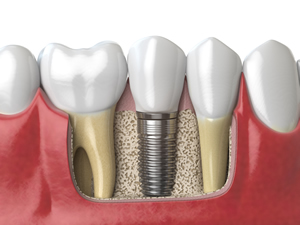
When a tooth goes missing, the underlying jaw bone no longer receives the necessary stimulation it needs to retain its form and density. Just like other bones in the body, the jaw bone needs a regular exertion of force (through biting and chewing) to trigger the shedding of old bone cells and the replacement of new cells. When a tooth and tooth root is extracted from the bone, the hole (or socket) leaves the bone void of proper stimulation. Thus, the gums and bone at the extraction site will slowly begin to resorb or deteriorate.
The problem with bone loss after missing teeth is that it can disqualify you from getting a dental implant. Implants require a certain height and density of bone for support and success. If too much time lingers between tooth loss and dental implant surgery, a bone graft may be needed. While bone grafting is common and straightforward, it is an additional expense, procedure and recovery that can be avoided.
Ideally, you should get an implant placed quickly after tooth removal. However, this isn’t always possible. Some patients need or prefer to wait for their implant surgery. In such cases, a socket preservation procedure should be strongly considered.
What is Socket Preservation?
After the tooth is removed, the dentist places bone graft material into the socket where the tooth was located. This material may be human bone, animal bone or a synthetic biocompatible material. Then a collagen barrier or membrane may be placed over the socket. The final step is to suture the gums over the socket to close it up.
This procedure preserves the alveolar ridge as well as protects the socket. Most importantly, this procedure allows patients to avoid a potential bone grafting procedure and still get an implant at a later date.
To learn more about socket preservation after tooth removal, please contact Ora Dental Implant Studio today.
Posted on behalf of Ora Dental Implant Studio
2733 Elk Grove Blvd, Suite 170
Elk Grove, CA 95758
Phone: (916) 546-7911
